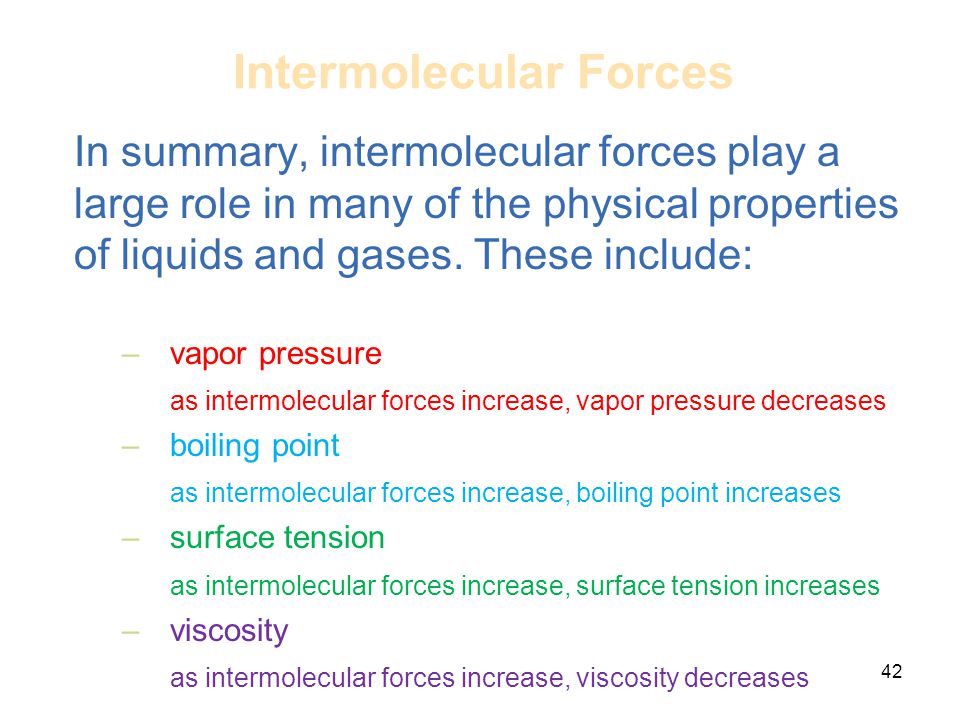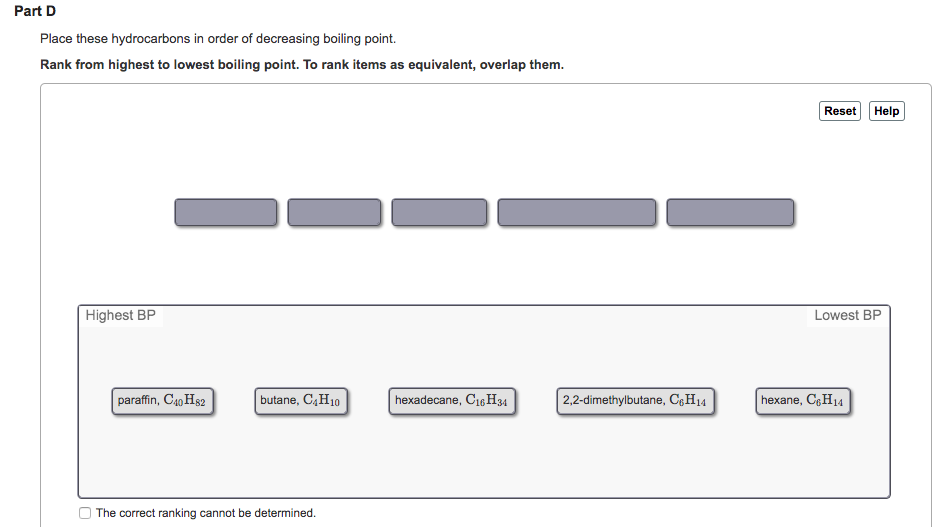As Intermolecular Forces Increase Which of the Following Decreases
Elasticity is due to intermolecular forces which decrease with increase of intermolecular distance Assertion. Entropy increases Entropy decreases c Dry ice solid CO2 sublimes.

1 Topic 11 Liquids And Solids 2 States Of Matter Comparison Of Gases Liquids And Solids Gases Are Compressible Fluids Their Molecules Are Widely Ppt Download
Elasticity is due to intermolecular forces which decreases with the increase of intermolecular distance.

. The vapor pressure of C 2 H 5 OH is higher. 9 Does nitrogen have a stable liquid state. The vapor pressure of a liquid.
As the polarity of a covalent compound increases the solubility of the compound in CCl4 decreases. Entropy increases Entropy decreases. If two molecules have about the same mass and size then dipole-dipole forces increase with increasing polarity.
Which one of the following decreases as the strength of the attractive intermolecular forces increases. B boiling point elevation. I ii and iii e.
The heat of vaporization. The normal boiling temperature 7. As intermolecular forces decrease which of the following will increase.
I Viscosity increases as temperature decreases. NH3 will have a lower vapor pressure at -50oC than NO. H-bond Dipole-dipole interaction London force.
For molecules of similar polarity those with smaller volumes often have greater dipole-dipole attractions. Select the best answer. Iii Viscosity increases as intermolecular forces increase.
Water exists in all three forms ie ice water and water vapour. Dispersion forces are the forces that make nonpolar substances condense to liquids and freeze into solids when the temperature is low enough. It is related to the ease with which molecules can move past each other.
None of the statements are correct d. Molecules are arranged tightly in ice less tightly in water and free in water vapour. As the intermolecular attraction increases The vapor pressure the pressure of the vapor that is in equilibrium with its liquid decreases The boiling point the temperature at which the vapor pressure becomes equal to the pressure exerted on the surface of the liquid increases Surface tension the resistance of a liquid to spread out and increase its surface area increases.
The normal boiling temperature. The sublimation temperature of a solid. Ion-dipole hydrogen bonding dipole-dipole and Van der Waals force.
Chapter 12 covers information about states of matter phase changes and intermolecular forces. Rank the following types of intermolecular forces in general order of decreasing strength strongest to weakest. D Ionic solids are insulators.
None of the above Answer Key. Which one of the following decreases as the strength of the attractive intermolecular forces increases. If only London force is operative in a compound then it should have very low boiling point.
As intermolecular forces increase which of the following decreases. Also that the force of intermolecular attraction is inversely proportional to distance between the particles. Boiling Point Melting Point Viscosity Surface Tension.
B Question 15 of 36 00 40 Points Which state of matter has a high density and a definite volume. The heat of vaporization 5. With increase of temperature elastic property of a substance decreases.
C Ionic solids have high melting points. The increased average kinetic energy keeps the molecules farther apart and moving around. Intermolecular forces are forces that exist between molecules and are collectively referred to as such.
Again the order of surface area amongst 1 2 and 3 compound is 123 consequently London force is in the order 123 and b. Intermolecular Forces Viscosity Resistance of a liquid to flow is called viscosity. Which intermolecular force increases with increasing molar mass.
Intermolecular Forces and the Limitations of the Ideal Gas Law At low temperatures gas particles have less kinetic energy and therefore move more slowly. As mentioned above the intermolecular attraction decreases. The relative strength of intermolecular forces.
London-Dispersion Forces These are the weakest of all intermolecular forces. E All of the statements A-D are correct. Viscosity Rate of Vaporization Boiling point O DO Melting point Surface tension Vapor Pressure Heat of vaporization 1 pts Question 4 When a solid is placed into a liquid and dissolves which of the following is true.
The extent of deviations from the ideal gas law 9. Which one of the following decreases as the strength of the attractive intermolecular. All of the following are colligative properties except.
Now as these things increase in strength it becomes harder to remove the molecules from each other. Cl2 will have a higher boiling point than Ar. 7 What kinds of interactions do intermolecular forces originate.
The vapor pressure of a liquid. Ii Viscosity increases as molecular weight increases. The sublimation temperature of a solid 11.
With increase in temperature elastic property of a substance decreases R. 5 Does an increase in pressure promote formation of a denser phase. What is the strongest intermolecular force.
This quiz is to test your knowledge about Chapter 12. Polarizability affects dispersion forces in the following ways. Does the entropy of the system increase or decrease in each of the following processes.
Sequential Easy First Hard First. 8 What are the key properties of liquids in contrast to gases and solids. A Pure gases are mixed to prepare an anesthetic.
That is Intermolecular Forces are forces of attraction that decreases as the distance between the molecules increases. As polarizability increases the dispersion forces also become stronger. I and iii c.
25Which is true when comparing samples of C 6 H 6 l has C-H bonds to C 2 H 5 OHl has an O-H bond. Viscosity increases with stronger intermolecular forces caused by increase in the molecular weight. 6 What are the main properties of liquids in contrast to gases and solids.
Decide if the following statements regarding Intermolecular forces are True or False. Select all that apply. The intermolecular forces increase in strength according to the following.
Entropy increases Entropy decreases b Electronic-grade silicon is prepared from sand. London dispersion dipole-dipole H-bonding ion-ion. This results in the increase of the average intermolecular distance.
B The binding forces in a molecular solid include London dispersion forces. At slower speeds they are much more likely to interact attracting or repelling one another upon collision. LiF will have a higher vapor pressure at 25oC than H2S.
Create your own Quiz.

Solubility Of Oxygen In Water Decreases With Rising Temperature Gases Have Weak Intermolecular Forces So There Are Relatively Weak Intermolecular Forces Betwe

Cambridge International As And A Level Chemistry Coursebook With Cd Rom By Cambridge University Press Education Issuu

Solved Part A What Happens To These Physical Properties As Chegg Com
No comments for "As Intermolecular Forces Increase Which of the Following Decreases"
Post a Comment